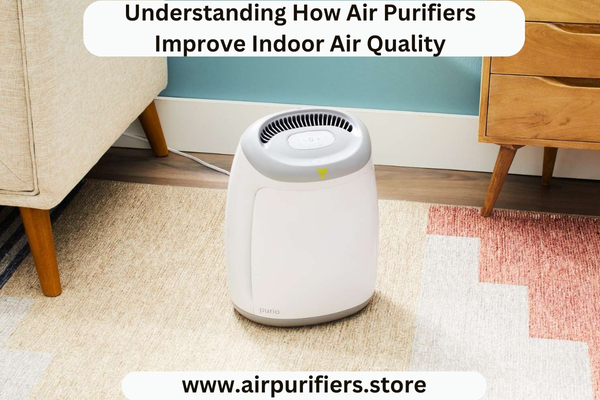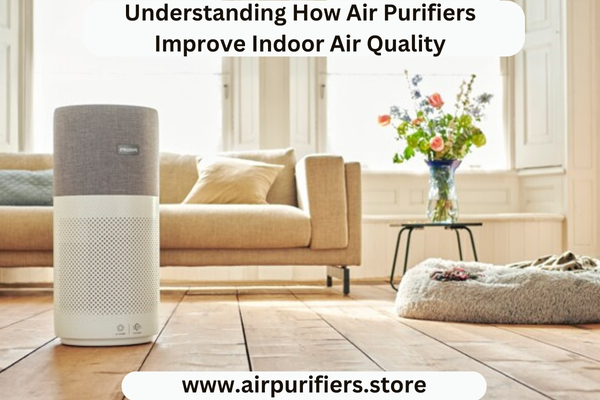Understanding How Air Purifiers Improve Indoor Air Quality
In today’s world, maintaining clean and healthy indoor air is a top priority. With concerns about allergens, pollutants, and odors, many people turn to air purifiers to enhance the air quality in their homes and workplaces. But how exactly do air purifiers work?
In this article, we will explore the inner workings of air purifiers, shedding light on their mechanisms and the benefits they offer for improving indoor air quality.
Click Here For Buying
-
The Basics of Air Purification
Air purifiers are devices designed to remove contaminants from the air, making it cleaner and healthier to breathe. They work by pulling in air from the surrounding environment and passing it through a series of filters or purification technologies.
-
Pre-Filtration: Capturing Larger Particles
Most air purifiers feature a pre-filter that serves as the initial line of defense. This filter captures larger particles like dust, pet hair, and lint, preventing them from clogging the main filter and prolonging its lifespan. Pre-filters are typically washable or replaceable, and they help maintain the overall efficiency of the air purifier.
-
Main Filtration: Trapping Microscopic Particles
The heart of an air purifier lies in its main filtration system. The type of filter used varies across different models, but the two most common types are High-Efficiency Particulate Air (HEPA) filters and activated carbon filters.
- HEPA Filters: HEPA filters are highly effective at capturing particles as small as 0.3 microns with an efficiency of 99.97%. They can trap common allergens like pollen, dust mites, mold spores, and pet dander. HEPA filters consist of a dense web of fibers that create a maze-like structure, effectively capturing particles as air passes through.
- Activated Carbon Filters: Activated carbon filters excel at adsorbing odors, gases, and chemical fumes. They contain a porous material called activated carbon, which has a large surface area for trapping and neutralizing various volatile organic compounds (VOCs), smoke, and unpleasant odors. This filter type is particularly beneficial for households with smokers or individuals with chemical sensitivities.

-
Additional Purification Technologies
Some air purifiers incorporate additional purification technologies to enhance their effectiveness:
- Ultraviolet (UV) Light: UV light can be used to destroy certain microorganisms like bacteria, viruses, and mold spores by disrupting their DNA structure. This technology is often combined with filters for comprehensive purification.
- Ionizers: Ionizers release negative ions into the air, which attach to airborne particles and cause them to clump together. These larger particles then become easier to capture by the filters or settle on surfaces, reducing their presence in the air.
-
Clean Air Discharge
Once the air has passed through the filtration system, the purified air is released back into the room. The circulation of clean air helps reduce the concentration of allergens, pollutants, and odors, creating a healthier indoor environment.
6. Types of Air Purifiers
While HEPA and activated carbon filters are the most common types of filters used in air purifiers, there are other specialized filtration technologies worth mentioning:
- Electrostatic Precipitators: These devices charge particles in the air using high-voltage electricity and then collect them on oppositely charged plates. This technology is effective at capturing small particles, including smoke and fine dust.
- Ozone Generators: Ozone generators produce ozone, a highly reactive gas that can neutralize odors and kill certain airborne bacteria and viruses. However, ozone can be harmful to humans in high concentrations, so caution is advised when using ozone-generating air purifiers.
- Photocatalytic Oxidation (PCO): PCO air purifiers use UV light in combination with a catalyst, typically titanium dioxide, to create a reaction that breaks down pollutants into harmless substances like carbon dioxide and water vapor. PCO technology is effective against volatile organic compounds (VOCs) and some bacteria and viruses.
7. CADR and ACH Ratings
When choosing an air purifier, two important ratings to consider are Clean Air Delivery Rate (CADR) and Air Changes per Hour (ACH).
- CADR indicates the volume of clean air an air purifier can deliver in cubic feet per minute (CFM). Higher CADR ratings for pollen, dust, and smoke indicate a more efficient air purifier.
- ACH represents the number of times an air purifier can completely exchange the air in a room within an hour. For optimal air quality, experts recommend an ACH rating of at least 4 to 6, meaning the air in the room is refreshed every 10 to 15 minutes.
8. Maintenance and Filter Replacement
Proper maintenance is crucial to ensure the optimal performance of an air purifier. Regularly cleaning or replacing filters is necessary to maintain their efficiency and prevent the buildup of captured particles. Most air purifiers have indicator lights or alarms that signal when it’s time to clean or replace the filters.
9. Limitations of Air Purifiers
While air purifiers can effectively capture many airborne particles, it’s important to note their limitations:
- Air purifiers are not a cure-all for poor indoor air quality. They primarily address airborne particles and odors, but they may not eliminate pollutants that have settled on surfaces or remove gases like carbon monoxide.
- Air purifiers cannot remove all types of allergens. Some allergens, such as pollen, can enter the room through open doors or windows. However, they can still help reduce the overall allergen load in the air.
- Air purifiers need to be properly sized for the room they are intended to clean. Using an undersized unit may result in insufficient air purification, while an oversized unit may consume unnecessary energy.

10. Benefits of Using Air Purifiers
- Allergy Relief: Air purifiers can provide relief for individuals who suffer from allergies by capturing common allergens like pollen, pet dander, and dust mites. This can help reduce symptoms such as sneezing, coughing, and itchy eyes.
- Asthma Management: Air purifiers can be particularly beneficial for individuals with asthma. By removing asthma triggers like dust, mold spores, and airborne irritants, air purifiers help create a cleaner and healthier indoor environment, potentially reducing asthma attacks and improving overall respiratory health.
- Odor and Smoke Reduction: Air purifiers equipped with activated carbon filters are effective at adsorbing odors from cooking, pets, and smoke. They can help eliminate lingering smells and improve the overall freshness of the indoor air.
- Improved Sleep: Cleaner air can contribute to a more restful night’s sleep. By reducing airborne allergens, pollutants, and irritants, air purifiers create a healthier sleep environment, potentially leading to better sleep quality and fewer disruptions.
11. Choosing the Right Air Purifier
- Room Size: Consider the square footage of the room where the air purifier will be used. Different air purifiers are designed for various room sizes, and selecting the appropriate size ensures optimal performance and air purification efficiency.
- Noise Levels: If you plan to use the air purifier in a bedroom or a quiet workspace, consider models with low noise levels to avoid disturbances.
- Energy Efficiency: Look for air purifiers with energy-efficient features, such as programmable timers or energy-saving modes. This can help minimize energy consumption and reduce long-term operating costs.
- Filter Replacement Costs: Take into account the cost and frequency of filter replacements. Some air purifiers have filters that need to be replaced every few months, while others have longer-lasting filters. Understanding the maintenance requirements helps in estimating ongoing expenses.
12. Complementary Strategies for Better Indoor Air Quality
- Ventilation: Proper ventilation is essential for maintaining good indoor air quality. Opening windows or using exhaust fans can help remove stale air and introduce fresh outdoor air.
- Regular Cleaning: Dusting, vacuuming, and mopping surfaces can minimize the accumulation of dust, allergens, and other particles. This, in conjunction with air purifiers, can significantly improve the overall cleanliness of the indoor environment.
- Source Control: Identifying and addressing the sources of indoor air pollutants is crucial. For example, reducing smoking indoors, using natural cleaning products, and keeping pets groomed can help minimize the introduction of pollutants into the air.
- Humidity Control: Maintaining appropriate humidity levels (ideally between 30% and 50%) helps prevent mold growth and the proliferation of dust mites. Dehumidifiers and humidifiers can be used to regulate moisture levels as needed.
13. Air Purifiers and COVID-19
Air purifiers cannot directly eliminate the SARS-CoV-2 virus, but they can help improve indoor air quality and potentially reduce the spread of respiratory droplets that may contain the virus. When used in conjunction with other preventive measures like mask-wearing, social distancing, and proper ventilation, air purifiers can contribute to a safer indoor environment.
Conclusion
Air purifiers play a vital role in improving indoor air quality by eliminating allergens, pollutants, and odors. By understanding the workings of air purifiers, including pre-filtration, main filtration with HEPA and activated carbon filters, and the integration of additional purification technologies, you can make an informed choice when selecting an air purifier that suits your specific needs.

